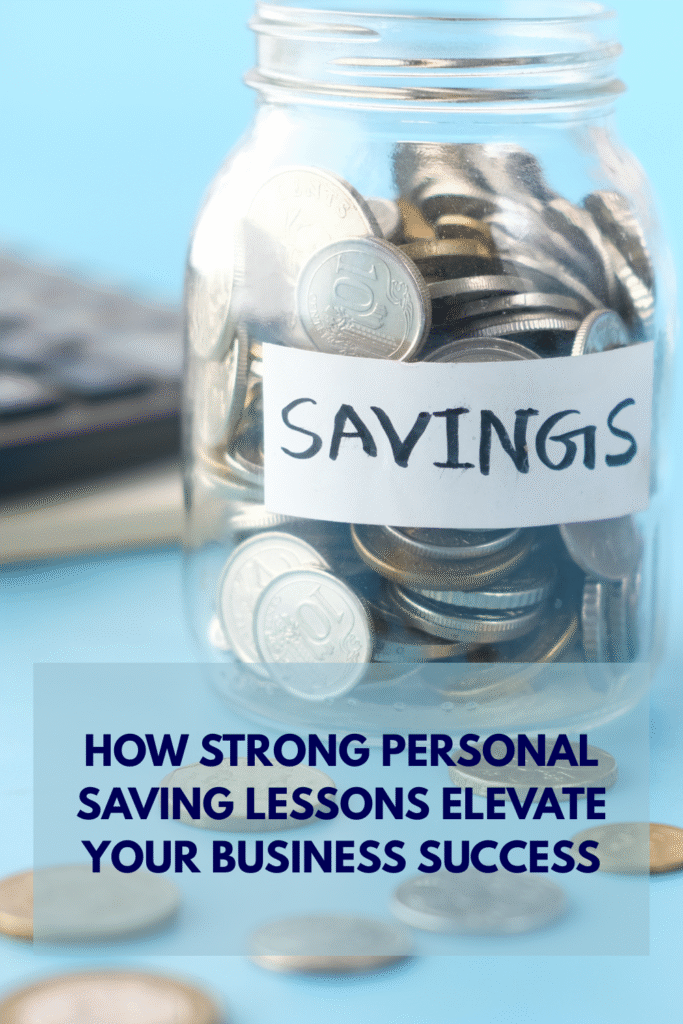
Table of Contents
Personal saving means keeping a portion of your income aside rather than spending it all. It’s money intentionally reserved for emergencies, goals, investments, and future peace of mind. But beyond numbers, personal saving is a habit — one that builds discipline, independence, and control.
When you understand how to do saving, you aren’t just stacking cash. You’re teaching yourself patience and balance — learning that money is a tool for freedom, not a chain of constant stress.
Why Is Personal Saving Important?
Every person needs a financial cushion. But for entrepreneurs and creators, the importance of personal saving multiplies.
- It brings security. Life is unpredictable — clients vanish, projects delay, crises appear. Personal saving protects you when business cash flow doesn’t.
- It gives freedom. With savings, you can say “no” to underpaying clients or bad partnerships.
- It calms your mind. A full savings account feels like a deep breath. You stop making fear-based decisions.
- It fuels dreams. Saving lets you invest in long-term goals — whether that’s expanding your business or buying your first property.
- It builds control. You move from reacting to planning — the foundation of smart entrepreneurship.
In short, saving is more than a financial move. It’s a psychological anchor that helps you stay strong in an unpredictable world.
Why Personal Saving Matters for Business
Entrepreneurs often think business and personal finances are separate. In reality, they’re intertwined. If your personal life is unstable, your business will reflect that tension.
Here’s how personal saving directly improves your business performance:
- Financial discipline: When you learn how to do personal saving, you naturally develop budgeting habits — the same discipline needed for profit management.
- Risk readiness: You can take bold steps in business because your personal base is covered.
- Better decision-making: Money stress leads to poor choices. Savings create clarity.
- Professional credibility: Clients trust financially grounded leaders.
- Freedom to grow: When personal bills don’t choke your cash flow, you can reinvest with confidence.
Personal saving is your quiet superpower — it won’t show in your LinkedIn bio, but it’s what makes your success sustainable.
How to Do Personal Saving: A Step-by-Step Framework
Saving isn’t magic — it’s structure. Here’s how to build a habit that lasts.
Step 1: Set a clear saving target
Decide your why — emergency fund, education, travel, investment, or future business security. Clear goals motivate consistency.
Step 2: Pay yourself first
Transfer 10-20% of your income into your personal saving account as soon as money hits. Treat it as a mandatory bill to your future self.
Step 3: Automate it
Use auto-debits so saving happens before spending. That’s the easiest way to master how to do saving without relying on willpower.
Step 4: Track your expenses
Know where your money goes. Apps or simple spreadsheets can reveal unnecessary leaks. Awareness drives smarter choices.
Step 5: Split your savings
Create multiple buckets:
- Emergency fund: 3–6 months of expenses.
- Short-term: Travel, gifts, or lifestyle upgrades.
- Long-term: Investments or retirement.
Step 6: Review quarterly
Income changes — so should your saving percentage. The goal is steady progress, not perfection.

Where to Invest Personal Saving: Smart Paths for Growth
Once you’ve built a habit, the next step is understanding where to invest personal saving so that your money grows intelligently.
a) Emergency fund in liquid accounts: Keep your short-term safety net easily accessible — a high-interest savings or liquid fund.
b) Fixed deposits or recurring deposits: Ideal for conservative savers who value safety and guaranteed returns.
c) Mutual funds / SIPs: For long-term growth, invest monthly through Systematic Investment Plans. Compounding builds wealth while keeping contributions manageable.
d) Self-investment: Use part of your saving to learn — courses, workshops, certifications. These give the highest lifetime ROI.
e) Diversify: Never put all eggs in one basket. Spread across fixed, liquid, and equity-based investments. Diversification keeps your saving stable through market changes.
f) Keep business separate: Your saving is your backup — not your business piggy bank. Mixing them is a recipe for confusion and risk.
Personal Saving Lessons That Strengthen Business Skills
Every quality that makes someone good at saving also makes them a better businessperson.
- Budgeting ? Smarter resource allocation
- Consistency ? Steady marketing and operations
- Delayed gratification ? Strategic patience with growth
- Evaluating ROI ? Smarter business spending
- Emergency planning ? Better crisis management
If you can control your personal money, you can control your business cash flow.
How Personal Saving Reduces Business Stress
When your personal saving is in place:
- You don’t take bad deals out of desperation.
- You don’t fear quiet months.
- You make creative decisions instead of survival decisions.
- You rest without guilt.
That sense of stability changes how you show up every day — calm, confident, and capable.
Common Mistakes to Avoid in Personal Saving
Even disciplined entrepreneurs fall into traps:
- Mixing accounts: Keep business and saving separate.
- Ignoring inflation: Idle cash loses value. Know where to invest saving for growth.
- Saving without purpose: Goals give savings direction.
- Over-reliance on credit: Saving should be your first defense, not credit cards.
- Breaking savings early: Avoid dipping into saving for short-term pleasure — protect it.
Tackling Common Fears: Saving Myths in Entrepreneurial Life
Let’s clear a few common misconceptions that stop entrepreneurs from building financial discipline:
Myth 1: “I’ll start saving once my business stabilizes.”
That’s backward. Personal saving is what gives you stability to build the business. Even ?1000 monthly matters.
Myth 2: “Investing saving in my business is smarter.”
Not always. Your business already carries risk. Saving should be your safe zone, not your gamble zone.
Myth 3: “Saving means I’m not ambitious.”
Wrong. Saving doesn’t kill ambition — it fuels sustainable ambition. You can’t grow if you’re broke.
Myth 4: “Where to invest saving can wait till I’m rich.”
You become rich because you start early. Compounding rewards the consistent, not the wealthy.
Myth 5: “Personal saving is boring.”
Actually, it’s freedom disguised as discipline. The peace you feel knowing your bills are covered is unmatched.
Facing these fears is half the battle. The rest is consistent action.
Where to Invest Saving: Tools and Checks for Indian / Small Business Context
If you’re an Indian entrepreneur, freelancer, or small business owner, these tools will help you decide where to invest personal saving safely and smartly.
- High-yield savings accounts: For liquidity and safety — good for emergency funds.
- Fixed Deposits (FDs): Reliable returns with low risk; ideal for conservative savers.
- Recurring Deposits (RDs): Great for those who want to build habit through monthly saving.
- Public Provident Fund (PPF): Long-term, tax-free, government-backed — excellent for retirement.
- Mutual Funds / SIPs: For moderate to aggressive growth over 5–10 years.
- National Pension Scheme (NPS): Long-term investment with tax advantages for retirement planning.
- Gold ETFs or Sovereign Gold Bonds: Hedge against inflation.
- Health and term insurance: Not exactly an investment, but critical to protect your saving from unexpected expenses.
- Skill investment: Workshops, online courses, certifications — they improve income potential, indirectly growing your saving.
Checks before investing:
- Never invest without a defined goal.
- Review risk appetite and liquidity needs.
- Avoid “get-rich-quick” schemes.
- Keep at least one portion of personal saving fully liquid.
- Consult a certified advisor for tax-linked products.
How to Connect Saving with Business Strategy
- Set parallel goals: Link saving targets with business revenue targets.
- Separate accounts: Maintain clarity between your personal and business funds.
- Allocate consistently: Transfer a small fixed percentage of profit into your saving monthly.
- Review quarterly: Track both personal and business growth together.
- Reinvest wisely: Use excess profit for strategic business expansion only after personal saving goals are secure.
Real-Life Reflection
Imagine you run a creative agency or blog. You’ve practiced saving for a year. You know exactly where to invest personal saving and have a 6-month emergency fund.
When a big client delays payment, you stay calm. Bills are paid, your team’s salaries aren’t delayed, and you continue to operate with dignity. That’s what personal saving does — it transforms chaos into control.
How to Build a Saving Routine That Lasts
Weekly rhythm:
- Monday: Track expenses.
- Wednesday: Transfer savings.
- Friday: Review where to invest personal saving next.
- Sunday: Reflect on progress and gratitude.
Routines make saving automatic and effortless.
The Emotional Power of Personal Saving
Personal saving isn’t about greed — it’s about peace. Each rupee saved is a statement of self-respect. It’s saying, I’ve got my back.
As that confidence grows, so does your business courage. You start operating from purpose, not panic. That’s the emotional backbone of long-term success.
Stability Before Scale :Before chasing profits, build your base. A house without foundation collapses — the same goes for business without personal saving. When you know how to do personal saving and where to invest personal saving, you create a structure that supports ambition instead of crushing it.
Personal saving turns your business from a survival act into a growth journey. It brings power, peace, and perspective — three things every entrepreneur desperately needs. So start today. Move a small amount to a separate account. Label it “My Freedom Fund.” That’s your first step toward empowered growth — the quiet proof that you’re building not just a business, but a life that lasts.
This post is a part of Blogchatter Half Marathon
© Ruchi Verma
Disclaimer: This article is not published as financial advice or any other financial legal issue. This post is written as an informational part, please read all guidelines carefully before investing in financial transactions. We recommend you consult your financial planner before investing in any financial decisions.
Copyright:
Unauthorized use or duplication without express and written permission from this site’s author and/or owner is strictly prohibited. Excerpts and links may be used, provided that full and clear credit is given to the original content.






